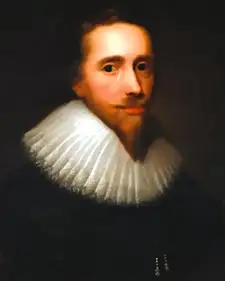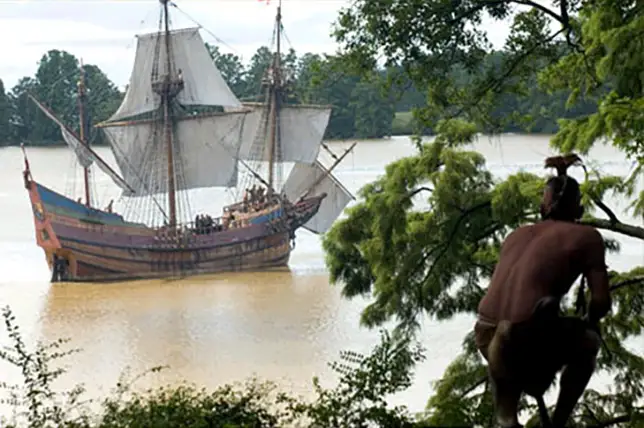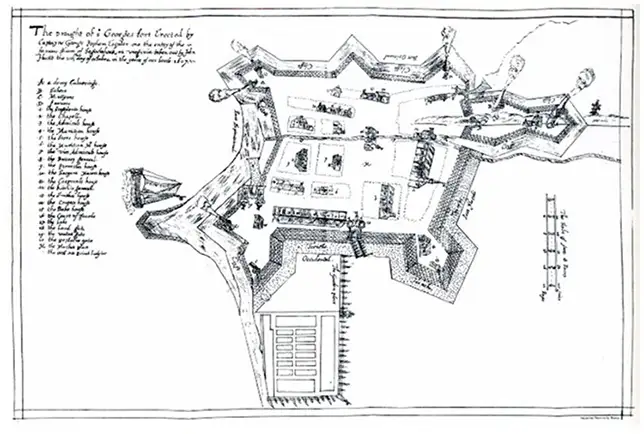
Raleigh Gilbert
Bartholomew’s brother Raleigh Gilbert became involved in the exploration/colonization business in 1606, when Queen Elizabeth’s successor James I founded the Virginia Company. Virginia was then the name for England’s entire claim to the east coast of North America from the northern border of New Spain (now the state of Florida) to the southern border of New France (what is now Canada). The Spanish had claimed the entire coast previously, but the English didn’t particularly let that bother them.
James granted charters for the establishment of colonies to competing factions within the Virginia Company: The London Company was to concentrate in the mid-Atlantic coast area, and the Plymouth Company was to work the Northeast coast, essentially what we now call New England.
Raleigh Gilbert
The London Company’s ships sailed from that city and established Jamestown that eventually became, despite a very rocky start, the first permanent English colony in the New World. George Popham (whose uncle Sir John, the Chief Justice of England, was a major underwriter of the venture) and Captain Raleigh Gilbert sailed with one hundred twenty settlers in the Plymouth Company’s ships from that port city on May 31, 1607, heading for the Maine coast. Journals of several key participants and one invaluable map have survived, giving a good history of the venture.

A typical armed English merchant ship, early 17th century (reproduction at Jamestown, VA)
The ships endured an unusually long crossing, arriving at the mouth of the Sagadahoc (modern Kennebec) River near what’s now Phippsburg, Maine, Popham on the Gift of God on August 13th, Gilbert on the John and Mary on the 16th. From the start, things did not go well between Popham, described by Sir Ferdinando Gorges, Military Governor of Plymouth, England, as “timorously fearful to offend,” and Gilbert, whom Gorges characterized as “desirous of supremacy and rule, a loose life, prompt to sensuality, little zeal in religion, humorous, headstrong and of small judgement and experience, other ways valiant enough.” There was also a great age difference between the two leaders, Popham being somewhere between 50 and 60, Gilbert a particularly lively and fractious 25.
Popham’s name went on the colony due, no doubt, to Sir John’s funding. The settlers of Popham enjoyed weather and sanitary conditions far better than those of their Jamestown counterparts who were drinking semi-brackish water tainted by run-off from their own latrines. Healthy and vigorous, they soon completed the star-shaped Fort St. George, protected by ditches and armed with nine cannon. Within the fort they constructed two major buildings: the Leader’s House and a Storehouse as well as dwellings and other structures for the colonists.
On October 8, 1607, colonist and draughtsman John Hunt drew a rigorously detailed and scaled map of the fort showing a total of 18 buildings including the two major ones as well as a chapel, guardhouse and a cooperage. He also showed a pinnace, a small sailing vessel, at anchor by the fort. As the pinnace had not yet been constructed by October 8th, it is uncertain how much else was only in the planning stage and not yet constructed.

Popham Colony Map – John Hunt
The map was rediscovered in 1888 in the Spanish National Archives of the Americas — stolen in England by a spy and sold to the Spanish Ambassador, who sent it to Spain as an indication of what the English were up to on Spanish land. The only known drawing of an early English colony made at the time of its construction from direct observation, Hunt’s map was so accurately surveyed and scaled that it became an invaluable tool to the location of buildings in the colony when the site was rediscovered in 1994. Hunt’s map has also aided interpretation of the sites of other early colonies, particularly Jamestown, whose fort has only recently been rediscovered and is now undergoing intensive excavation.
The coming of winter exposed some problems. The settlers’ August arrival was too late for planting and harvesting a crop. Popham and Gilbert’s relations with the local Abenaki and Pemequid were polite but not cordial — the tribes remembered earlier European expeditions (Gilbert & Gosnold? The Spanish? The French?) that had kidnapped their people to show off in Europe. About half the settlers returned to England aboard the Gift of God in early December, leaving the remainder to try to survive on the short remaining provisions.
The winter was brutally cold, and factions developed in support of either Popham or Gilbert. Trading for furs was begun, but some sort of gathering of settlers and natives got out of hand in a tug of war contest involving a cannon that discharged, creating chaos. A powder keg exploded, burning down the storehouse and another building.
On February 5th, George Popham died and Raleigh Gilbert became President of the Colony. Under his direction the colony’s major achievement was realized, the construction of the 50′ pinnace Virginia of Sagadahoc, that explored the immediate coast and some of the Kennebec River, proving that colonies in the New World could successfully serve deforested England’s ship building needs. In the spring, the Gift of God arrived with much needed supplies and news that Sir John Popham was dead. But Raleigh Gilbert was able to send a large cash crop of sarsaparilla back to England on the John and Mary, so the summer was generally filled with optimism for the colony’s future.
The John and Mary returned with supplies in late August, this time with news that Raleigh Gilbert’s elder brother John had died, leaving him heir to all the family’s interests and its ancestral seat, Compton Castle in Devon. It took Gilbert little time to decide to abandon his command, and to convince the forty-five remaining settlers to return to England. As much of value as possible was crated and packed, the two ships and the pinnace Virginia setting out for England in Early September. But for stronger leadership, Popham might have been the first permanent English colony in the New World.

